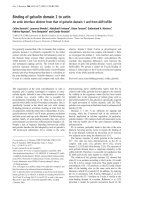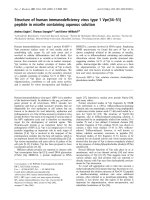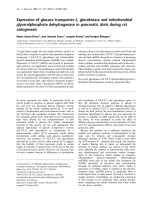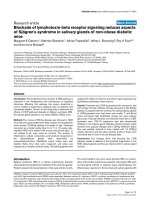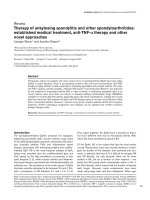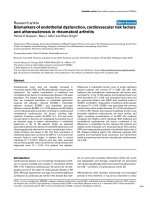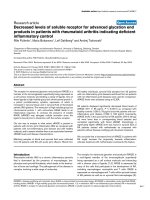Báo cáo y học: "Blockade of Toll-like receptor 2 prevents spontaneous cytokine release from rheumatoid arthritis ex vivo synovial explant cultures" ppsx
Bạn đang xem bản rút gọn của tài liệu. Xem và tải ngay bản đầy đủ của tài liệu tại đây (504.71 KB, 9 trang )
RESEARCH ARTIC LE Open Access
Blockade of Toll-like receptor 2 prevents
spontaneous cytokine release from rheumatoid
arthritis ex vivo synovial explant cultures
Sinéad Nic An Ultaigh
1
, Tajvur P Saber
1
, Jennifer McCormick
1
, Mary Connolly
1
, Jerome Dellacasagrande
2
,
Brian Keogh
2
, William McCormack
2
, Mary Reilly
2
, Luke A O’Neill
2
, Peter McGuirk
2
, Ursula Fearon
1
, Douglas J Veale
1*
Abstract
Introduction: The aim of this study was to examine the effect of blocking Toll-like receptor 2 (TLR2) in rheumatoid
arthritis (RA) synovial cells.
Methods: RA synovial tissue biopsies, obtained under direct visualization at arthroscopy, were established as
synovial explant cultures ex vivo or snap frozen for immunohistology. Mononuclear cell cultures were isolated from
peripheral blood and synovial fluid of RA patients. Cultures were incubated with the TLR1/2 ligand, Pam3CSK4
(200 ng, 1 and 10 μg/ml), an anti-TLR2 antibody (OPN301, 1 μg/ml) or an immunoglobulin G (IgG) (1 μg/ml)
matched control. The comparative effect of OPN301 and adalimumab (anti-tumour necrosis factor alpha) on
spontaneous release of proinflammatory cytokines from RA synovial explants was determined using quantitative
cytokine MSD multiplex assays or ELISA. OPN301 penetration into RA synovial tissue explants cultures was assessed
by immunohistology.
Results: Pam3CSK4 significantly upregulated interleukin (IL)-6 and IL-8 in RA peripheral blood mononuclear cells
(PBMCs), RA synovial fluid mononuclear cells (SFMCs) and RA synovial explant cultures (P < 0.05). OPN301
significantly decreased Pam3CSK4-induced cytokine production of tumour necrosis factor alpha (TNF-a), IL-1b, IL-6,
interferon (IFN)-g and IL-8 compared to IgG control in RA PBMCs and SFMCs cultures (all P < 0.05). OPN301
penetration of RA synovial tissue cultures was detected in the lining layer and perivascular regions. OPN301
significantly decreased spontaneous cytokine production of TNF-a, IL-1b, IFN-g and IL-8 from RA synovial tissue
explant cultures (all P < 0.05). Importantly, the inhibitory effect of OPN on spontaneous cytokine secretion was
comparable to inhibition by anti-TNFa monoclonal antibody adalimumab.
Conclusions: These findings further support targeting TLR2 as a potential therapeutic agent for the treatment of RA.
Introduction
Rheumatoid arthritis (RA) is a chronic inflammatory
disease characterized by synovial inflammation and
destruction of cartilage and bone. This process depends
on cytokines and growth factors to stimulate cell survi-
val, proliferation and extracellular matrix (ECM) degra-
dation [1]. Activated lymphocytes play a critical role in
the initiation and perpetuation of synovial inflammation.
Pro-inflammatory cytokines, such as TNF-a and IL-1 b,
are key mediators of these processes; however, it
remains unclear which mechanisms are involved in the
initiation and regulation of cytokine production and
other tissue-destructive mediators.
Thereismountingevidencefortheinvolvementof
Toll-like receptors (TLRs) in RA [2,3]. Increased expres-
sion of TLR2 and TLR4 has been demonstrated in syno-
vial cells and tissue [4-6]. TLR2 expression in RA
synovial tissue has been demonstrated at sites of attach-
ment and invasion into cartilage and bone [4], o n CD16
+ monocytes and synovial macrophages [5]. TLR2
mRNA is upregulated in RA synovial fibroblasts (FLS)
by TNFa an d IL-1b [4]. Overexpression of dominant
* Correspondence:
1
Department of Rheumatology, St Vincent’s University Hospital, Dublin
Academic Medical Centre, Elm Park, Dublin 4, Ireland
Full list of author information is available at the end of the article
Nic An Ultaigh et al. Arthritis Research & Therapy 2011, 13:R33
/>© 2011 Nic An Ultaigh et al.; licensee BioMed Central Ltd. This is an open access article distributed under the terms of the Creative
Commons Attribution License ( which permits unrestricted use , distribution, and
reproduction in any medium, provided the original work is properly cited.
negative forms of the essential TLR2/4 adapter mole-
cules MyD88 and Mal/TIRAP inhibits cytokine produc-
tion and matrix metalloproteinases in RA synovial cells
[6]. Furthermore, several animal models use bacterial
wall components and peptidoglycans (PG), known to
activate TLR2, to induce experimental arthritis [7,8].
Targeted biologic therapies, including TNF blocking
drugs, have had an important effect on the therapeutic
outcome of inflammatory arthritis [9]; however, a signif-
icant proportion of patients do not respond or have a
sub-optimal response highlighting the need for n ew
therapeutic targets. TLR expression on RA cells and
theirabilitytoinducepro-inflammatory cytokines, sug-
gest TLRs may play an integral role in the pathogenesis
of RA, as such TLRs represent a rational target for ther-
apeutic intervention [3].
In the p resent study, using whole tissue synovial
explant cultures ex vivo (which closely reflect the in vivo
environment) and RA mononuclear cells, we demon-
strate that Pam3CSK4, a TLR1/2 agonist, significantly
increases release of key cytokines, an effect that is
blocked by an anti-TLR2 antibody, OPN301. In RA
synovial explants, we demonstrate that OPN301 pene-
trates the s ynovial tissue, localizing to the lining layer
and perivascular regi on and significantly suppresses
spontaneous release of pro-inflammatory cytokines. This
effect was comparable to that of Adalimumab, a well
established TNF blo cking therapy. Inhibition of sponta-
neous pro-inflammatory cytokine production by
OPN301 from RA synovial explants in the absence of a
specific TLR2 agonist suggests expression of endogenous
TLR ligands in RA synovial tissu e. These data demon-
strate that TLR2 p romotes pro-inflammat ory and
destructive processes in RA and further support the
rationale of using a TLR2 therapeutic blockade.
Materials and methods
Patients and RA synovial tissue
Patients with RA, classified according to the American
College of Rheumatology criteria [10], were recruited
from rheumatology outpatient clinics at St. Vincent’s
University Hospital (SVUH). All patients had an actively
inflamed knee joint, despite current or previous therapy.
All research was carried out in accordance with the
Declaration of Helsinki, following approval by the
SVUH ethics committee. All patients gave written
informed consent. RA synovial tissue (ST) was obta ined
at the time o f arthroscopy under direct visualization.
Blood samples and synovial fluid were collected from
patients at arthroscopy or clinics.
Whole RA synovial tissue explant culture
To investigate the effect of OPN301 (a novel mous e IgG1
monoclonal anti-TLR2 antibody, Opsona Therapeutics,
(Dublin, Ireland)), on cytokine production in the arthritic
joint, an ex vivo RA synovial explant model was estab-
lished. This system maintains the synovial architecture
and cell-cell contact and spontaneously releases pro-
inflammatory mediators [11,12]. OPN301 is an Opsona
Therapeutics internal designation for the anti-mouse/
human TLR2 monoclonal antibody known as T2.5.
OPN301 is a mouse IgG1 antibody that selectively inhi-
bits TLR2 signaling [13]. IC50s for cytokines measured
ranged from 10 to 30 ng/ml for OPN301 and 1 to 10 ng/
ml for Adalimumab (Humira, Abbott Laboratories, Illi-
nois, USA). OPN301 cross reacts with mouse TLR2 but
has been shown to be ineffective at inhibiting TLR4 or
IL-1 receptor signaling in HEK293 or RAW264.7 cells
[14]. OPN301 is capable of inhibiting responses using
ligands specific for TLR1/2 (Pam3CSK4) and TLR2/6
responses (FSL1/HKLM) in human and murine cell lines
(THP1 CD14 X blue, U937, J774), and also in human,
murine and monkey blood (Opsona, unpublished
observations).
For Pam3CSK4 stimulation experiments, two biopsies
were obtained from each patient (n =11forIL-6and
n = 8 for IL-8) and each biopsy was sectioned into four
separate pieces and cultured in 96-well plates in serum-
free RPMI 1640 for 24 hr and then stimulated with
Pam3CSK4 (200 ng, 1 μg/ml and 10 μg/ml) for a further
24 hr. For the inhibition experiments, three biopsies
were obtained from each patient (n =13),andthen
each biopsy was sectioned into four separate pieces and
cultured in 96-well plates in full RPMI 1640 medium
(10%FoetalCalfSerum,20mMof1mmole/litre
HEPES, streptomycin (100 units/ml), penicillin
(100 units/ml) and Fungizone (0.25/μg/ml)) in the pre-
sence of OPN301 (1 μg/ml), Adalimumab (1 μg/ml) or
IgG isotype control (MouseIgG1isotypecontrol,
Opsona Therapeutics; 1 μg/ml) for 72 hr at 37°C in air
with 5% CO
2.
Following incubation, supernatants were
harvested and frozen at -80°C until further use, and the
wet weight of each biopsy section was obtained. Cyto-
kine production was corrected for by wet weight of the
biopsy.Biopsieswerethensnapfrozeninoptimalcut-
ting temper ature (OCT) compound and stored at -80°C
for histological analysis. To assess cell viability in RA
synovial explant c ultures following culture, the aceto-
methoxy derivate of calcein (calcein AM) was used as a
marker of viability. It transports through the cellular
membrane of live cells, where intracellular esterases
remove the acetomethoxy group resulting in a strong
green fluorescence. Following culture, explants were
incubated in PBS/Calcein AM (1:1,000 dilution) in t he
dark for 15 minutes. Biopsies were washed in PBS and
examined immediately under a fluorescent microscope.
Synovial cells emitted a strong green fluorescenc e indi-
cative of live cells.
Nic An Ultaigh et al. Arthritis Research & Therapy 2011, 13:R33
/>Page 2 of 9
Immunohistochemistry
Synovial biopsies obtained at arthroscopy and RA ST
obtained after explant cultures were snap frozen in OCT
andstoredat-80°C.7μm OCT sections were cut with a
cryostat, placed on glass slides coate d with 2% 3-amino-
propyl-triethoxy-silane (Sigma-Aldrich Irela nd, Ltd,
Dublin, Ireland) and dried overnight at room tempera-
ture. Tissue sections were allowed to reach room tem-
perature, fixed in acetone for 10 minutes and air-dried.
Non-specific binding and endogenous peroxidase activity
was blocked using 10% casein and 0.3% H
2
O
2
, respec-
tively. A routine three-stage immunoperoxidase labelling
technique incorporating avidin-biotin-immunoperoxidase
complex (DAKO, Glostrup, Denmark) was used. For RA
biopsies obtained directly from arthroscopy, the sections
were incubated with OPN301 at room temperature for
one hour. Sections were also incubated with an irrelevant
isotype matched mouse monoclonal antibody (mAb) as a
negative control. For the RA synovial explant sections
that were cultured with OPN301 or matched IgG control
antibody, the primary antibody step was omitted in order
to examine if tissue penetration of OPN301 mAb could
be detected. All sections were incubated with mouse sec-
ondary antibody/HRP for 30 minutes, washed in PBS and
colour-developed in a solution containing diaminobenza-
dine-tetrahydrochloride (Sigma, St Lo uis, MO, USA),
0.5% H
2
O
2
in PBS buffer (pH 7.6). Slides were counter-
stained with haematoxylin and mounted.
Isolation and culture of peripheral blood (PBMC) and
synovial fluid mononuclear cells (SFMC)
Blood and synovial fluid were obtained from patients
undergoing arthroscopy or at clinics, and drawn into
heparin containing tubes. PBMCs/SFMCs were isolated
by Ficoll-Metrizoate density gradient centrifugation
(Lymphoprep, Nycomed, Marlow Buckinghamshire,
UK). Cells were seeded in 48-well plates, at a cell den-
sity of 200,000 to 400,000 cells/ml i n full RPMI 1640
medium containing Pam3CSK4 (200 ng/ml, 1 μg/ml or
10 μg/ml) in the presence or absence of OPN301 or IgG
isotype control for 6 hr. To assess viability of cells after
stimulation with Pam3CSK4 and/or OPN301, PBMCs
were stimulated with Pam3CSK4 1 μgand/orOPN301
1 μg for 24 hrs. PBMC cell suspension was diluted 1:20
in Ethidium Bromide Acridine Orange solution (EBAO).
Viable and n on-viab le cells were coun ted using a dual-
chamber hemocytometer and a UV-light microscope.
No difference for cell viability was observed between
control and Pam3CSK or OPN treated cells.
Cytokine quantification
IL-6, IL-8, IFN-g,IL-1b,andTNF-a, levels were quan-
tified by Multiplex Tissue Culture kit (Meso Scale Dis-
covery (MSD), Maryland, USA) or by ELISA (R&D
Systems, Oxfordshire, UK) according to the manufac-
turer’ s instructions. Absorbance was measured at
450 nm in a microtiter plate spectrophometer (Dyna-
tech MR4000, Alexandria, VA, USA) or using MSD
Sector Imager 2400.
Statistical analysis
SPSS15 system for Windows (SPSS Inc, Chicago, Illinois,
USA) was used for statistical analysis. Non-parametric
Wilcoxon Signed Rank test for related samples and non-
parametric Friedman analysis of variance for comparison
ofthreeormoregroupswereperformed.P <0.05was
determined as statistically significant. Results are
expressed as mean ± SEM unless otherwise stated.
Results
Patient characteristics
Clinical charact eristi cs of the study patien ts who under-
went arthroscopy are shown in Table 1. All patients had
clinically active disease as estimated by high 28-joint
count Disease Activity Score (DAS28) (4.1 ± 0.9;
mean ± SD) and had a swollen , inflamed knee joint. All
patients except one were biologically naive. Eight
patients were receiving disease modifying antirheumatic
drugs (DMARDs) - either Methotrexate or Plaquenil. In
addition, three were receiving oral steroids (prednisilone
≤10 mg) and four patients were receiving NonSteroidal
Anti-inflammatory Drugs (NSAIDs) only. One patient
had previously received M ethotrexate/Adalimumab had
stopped treatment due to infection. There was no rela-
tionship between response to OPN301 and treatment.
Effect of Pam3CSK4 on cytokine production
To determine the effect of the TLR2 agonist Pam3CSK4
on induction of cytokine secretion in RA cells types, th e
expression of pro-inflammatory cytokines IL-6 and IL-8
were assessed. Figure 1A and 1B demonstrates in RA
SFMC and PBMC, significant induction of IL-6 and IL-8
secretion following Pam3CSK4 (200 ng/ml) stimulation
(P < 0.05). Incubation of PBMC and SFMC with
Pam3CSK4 at 1 and 10 μg/ml also signi ficantly induced
IL-6 and IL-8 production (P < 0.05) (data not shown).
Table 1 Characteristics of RA patients (n = 13)
Age, mean (range) years 58.07 (29 to 83)
Disease duration, mean (range) years 6.1 (0.6 to 14)
Rheumatoid factor - positive 8
- negative 5
No. of patients on DMARDs 8
No. of patients on NSAIDS 4
Physician’s global assessment, 0 to 100 mm VAS 26.4 ± 25.8
ESR, mm/hr 24.8 ± 9.5
CRP, mg/dl 20.9 ± 18.7
DAS28, units 4.1 ± 0.9
Nic An Ultaigh et al. Arthritis Research & Therapy 2011, 13:R33
/>Page 3 of 9
In RA synovial biopsies, TLR2 was localized to the lining
layer and perivascular regions as demonstrated by staining
using OPN301 as a primary antibody (Figure 2A). In
paired RA synovial explant cultures, Pam3CSK4, at 200
ng/ml , 1 and 10 μg/ml significantly induced IL-6 and IL-
8-cytokine production (Figure 2B). IL-6 production (mean
pg/ml/mg ± SEM) increased from 14,934.9 ± 8,337.15 for
an unstimulated control (Basal) to 23,783.02 ± 11,425.55
for Pam3CSK4 200 ng, P = 0.005; 66,811.71 ± 25,049.62
for Pam3CSK4 1 μg, P = 0.000 and 53,560.05 ± 13,547.85
for Pam3CSK4 10 μg, P = 0.000, respectively. IL-8 produc-
tion (mean pg/ml/mg ± SEM) increased from 30,196.87
± 8,871.838 for unstimulat ed control (Basal) to 81,931.94
± 32,328.61 for Pam3CSK4 200 ng, P = 0.012; 154,736.9 ±
43,381.3 for Pam3CSK4 1 μg, P = 0.000 and 140,520.4 ±
28,061.14 for Pam3CSK4 10 μg, P = 0.004, respectively.
Effect of OPN301 on cytokine production in PBMC and SFMC
To assess whether OPN301 inhibits Pam3CSK induced
cytokine secretion, RA PBMC and SFMC were stimu-
lated with Pam3CSK4 (200 ng/ml) in the presence or
absence of OPN301 or matched IgG isotype control.
OPN301 significantly inhibited Pam3CSK4 induced IFN-
g,IL-1b,IL-6,TNF-a and IL-8 in RA SFMCs (all P <
0.05) compared to IgG isotype co ntrol (Figure 3). Simi-
lar results were obt ained for RA PBMCs, where
OPN301 significantly inhibited IFN-g,IL-1b,TNF-a,
IL-8, IL-6 cytokine production (all P < 0.05).
OPN301 penetration and its effect on spontaneous
cytokine production in RA synovial tissue explant cultures
To show that OPN301 penetr ates the RA ST in culture,
biopsies were snap frozen following 72 h incubation
with OPN301, sectioned and immunohistology per-
formed omitting the primary antibody. Representative
images of OPN301 detection in RA synovial explants
are shown in Figure 4A. OPN301 was localized to the
lining layer and to the perivascular regions, showing
that OPN301 does penetrate the tissue in culture with
localization consistent with previous studies [4-6].
To determine the inhibitory effect of OPN301 on spon-
taneous cytokine production by ST explant cultures,
(B)
(
A
)
*
*
0
5000
10000
15000
20000
IL-6 pg/ml
0
20000
40000
60000
80000
IL-8 pg/ml
PBMC
PBMC
*
*
0
200
400
600
800
1000
IL-6 pg/ml
SFMC
0
10000
20000
30000
IL-8 pg/ml
SFMC
Basal Pam
200ng/ml
Basal Pam
200n
g
/ml
Basal Pam
200n
g
/ml
Basal Pam
200ng/ml
Figure 1 Pam3CSK4 induced IL-6 and IL-8 in mononuclear cells from RA patients. SFMCs (A; n = 6) and PBMCs (B; n = 11) were stimulated
with TLR2 agonist Pam3CSK4 at 200 ng/ml. Levels of IL-6 and IL-8 in the culture supernatants were determined and compared to unstimulated
cells (Basal) at six hours. Values are expressed as the mean ± SEM. * P < 0.05, significantly different from control as determined using Wilcoxon
Signed Rank analysis.
Nic An Ultaigh et al. Arthritis Research & Therapy 2011, 13:R33
/>Page 4 of 9
RA ST explants were established and cultured in the pre-
sence of OPN301 (1 μg/ml), Adalimumab (1 μg/ml) or
IgG isotype control (1 μg/ml) for 72 hr (Figure 4B).
OPN301 significantly inhibited spontaneous release of
IL-8 (P = 0.001), TNF-a (P = 0.003), IFN-g ( P = 0.013),
and IL-1b (P = 0.039). OPN301 inhibited IL-6 production,
but this did not reach signifi cance (P =0.056).Adalimu-
mab significantly inhibited IL-6 (P =0.002),IL-8(P =
0.000), IL-1b (P =0.020),TNF-a (P =0.018),andIFNg
(P = 0.001). The effect of OPN301 and Adalimumab on
spontaneous cytokine production was also analysed using
non-parametric Friedman analysis of variance, which
further confirmed significant inhibition of all cytokines in
response to both antibodies. We categorized the cytokine
responses in the tissue cultures as follows, low response:
<20% inhibition, moderate response: 21 to 49% inhibition,
and good response: >50% inhibition. For OPN301, 38% of
patients had a low response, 32% had a moderate response
and 30% had a good response, while biopsies treated with
Adalimumab showed 37% low response, 31% moderate
response and 32% good response. The rate of response
reflectswhatisobservedforTNFa in clinical practice,
(approximately 30% little or no response, and 70% of
patient responses varying between 20 to 100%). Therefore,
the results of our ex vivo model very much reflect typical
biologic response rates for RA patients in clinical practice,
and thus further validates the model as a good screening
method for pre-clinical ‘proof of concept studies’.
(A)
(B)
Pt 1 OPN301
Pt 1 IgG1
Pt 2 OPN301
Pt 2 IgG1
0
20000
40000
60000
80000
100000
Basal 200ng 1ȝg 10ȝg
Pam3
CS
K4
IL-6 pg/ml/mg
*
*
*
0
50000
100000
150000
200000
250000
Pam3CSK4
Basal 200ng 1ȝg 10ȝg
IL-8 pg/ml/mg
*
*
*
Figure 2 TLR2 expression is localized to the perivascular region and lining layer. (A) Two representative photomicrograph (Pt 1 and Pt 2)
of RA synovial tissue of 10 patients stained for TLR2 expression. Expression is localized to the perivascular region and to the lining layer, with no
staining observed for matched IgG control. The bar on the lower right hand corner of each photomicrograph represents a distance of 100 μm
on the top panel and 50 μm on the bottom panel. (B) RA synovial tissue explant cultures were stimulated with TLR2 angonist Pam3CSK4 at
200 ng, 1 and 10 μg/ml. Levels of IL-6 (n = 11) and IL-8 (n = 8) in the culture supernatants were determined after 24 hrs. Values are expressed
as the mean ± SEM. * P < 0.05 significantly different from control as determined using Wilcoxon Signed Rank analysis.
Nic An Ultaigh et al. Arthritis Research & Therapy 2011, 13:R33
/>Page 5 of 9
Discussion
TLRs are phylogenetically conserved receptors involved
in the innate immune response to microbial pathogens
through recognition of pathogen associated molecular
patterns (PAMPs). Recent studies have shown that TLRs
recognize endogenous ligands, found in RA serum and
synovial fluid [15,16], these ligands can be released from
necrotic cells during tissue damage or cell stress, leading
to TLR mediated immune re sponses [17-19]. Expression
and a ctivation of TLR 2, 3, 4 and 9 in RA ST has been
demonstrated suggesting TLRs may be involved in the
pathogenesis [4,20].
In this study we demonstrated that the TLR2 agonist
Pam3CSK4 significantly upr egulated pro-inflammatory
cytokine production in R A mononuclear cells, an effect
that was significantly blocked by OPN301. This is con-
sistent with previous studies using RA FLS, where PG, a
bacterial derived TLR2 agonist, significantly induced
angiogenic factors, pro-inflammatory chemokines and
cytokines [21-23]. This effect was inhibited by approxi-
mately 40% in the presence of an anti-TLR2 mAb [23].
Furthermore, studies using dominant negative forms of
the essential TLR2/4 adapter molecules MyD88 and
MAL/TIRAP also showed a partial inhibitory e ffect,
which varied considerably depending on the cytokine
analyzed, suggesting intricate signaling pathways are
involved in this complex inflammatory environment [6].
A key role for TLR2 in RA is further supported by evi-
denc e from animal models. TLR2 and MyD88 knockout
mice are protected from SWC induced joint inflamma-
tion [24]. Intra-articular injection of the TLR2 and
NOD2 ligand PG led to development of destructive
arthritis in mice [8]. Functional studies have shown that
stimulating TLR2 expressing RA fibroblasts with PG,
leads to induction of cytokines and matrix-metallopro-
teinases [23]. TLR2 ha s also been implicated in other
inflammatory diseases such as atherosclerosis and
inflammatory bowel disease [25,26].
TLR2 expression was localized to synovial tissue lining
and sub-lining layers of RA patients, which is cons istent
with previous studies. In situ hybridization revealed
TLR2 mRNA expression in the synovial lining, small
vessels and in areas of infiltrating lymphocytes [4].
TLR2 and TLR4 expression has also been shown in the
lining, sublining and perivascular regions of RA synovial
tissue, with TLR2 expression higher than that of TLR4
[23]. TLR2 is also expressed at the sites of attachment
and invasion into cartilage and bone [4]. Furthermore,
*
*
*
0
20
60
100
140
1
IL-1E pg/ml
0
5
15
25
35
1
IFN-Ȗ pg/ml
*
0
10000
20000
30000
40000
1
IL-8 pg/ml
0
200
400
600
800
1000
1
IL-6 pg/ml
*
0
500
1000
1500
2000
2500
1
TNF-Į pg/ml
IgG1 1ȝg + Pam 200ng/ml
OPN301 1ȝg + Pam 200ng/m
l
Figure 3 OPN301 significantly inhibited cytokine production in SFMC compared to IgG isotype control. RA SFMCs (n =6)were
stimulated with Pam3CSK4 in the presence or absence of OPN301 (1 μg/ml) or matched IgG isotype control for six hours. Values are expressed
as the mean ± SEM. * P < 0.05, significantly different from control as determined using Wilcoxon Signed Rank analysis.
Nic An Ultaigh et al. Arthritis Research & Therapy 2011, 13:R33
/>Page 6 of 9
in this study we show that OPN301 directly penetrated
RA synovial explant cultures, localizing to the lining
layer, which is comprised of synoviocyte-like fibroblasts
and macrophages and to the perivascular region where
angiogenesis and leukocyte extravasation occurs, critical
mechanisms in the pathogenesis of RA. Cons istent with
this localization, TLR2 is functionally active in synovial
fibroblasts and endothelial cells, where its activation
results in induction of VEGF, IL-8, ICAM-1, VCAM-1
and MMPs [15,21,22,27-29]. Moreover, several studies
have demonstrated that TLR2 activation of monocytes
resulted in an increase in adhesive and migratory capa-
city of cells [29].
In this study we used an ex vivo RA ST explant model
to investigate the role of TLR2 blockade in RA synovial
inflammation. This model more closely reflects the in
vivo joint environment, as it maintains tissue archite c-
ture and cell-cell contact of the complex mix of differ-
ent cell types whose interaction contributes to the
pro-inflammatory environment in the RA joint. Further-
more, RA synovial explants spontaneously release key
pro-inflammatory cytokines and, therefore, this model is
ideal for examining potential therapeutic molecules. We
demonstrated that OPN301 significantly inhibited
spontaneous secretion of TNFa,IL-1b,IFNg and IL-8,
suggesting that TLR2 is important in R A pathogenesis.
The inhibitory properties of OPN301 and Adalimumab
on spontaneous release of proinflammatory cytok ines in
our explant model reflect response rates observed in
routine clinical practice.
Activation of TLRs by local endogenous ligands lead-
ing to increased proinflammatory cytokine/chemokine
secretion, may result in a vicious cycle of inflammation,
ultimately leading to the pathological destruction of car-
tilage and bone seen in RA [2]. While bacterial TLR
ligands have been found in RA synovial fluid and tissue,
they have also been found in normal tissue [30]. Endo-
genous TLR ligands, which are released under inflam-
matory conditions and in response to tissue damage,
have now been implicated in RA. Evidence for TLR4
ligands have been demonstrated, where RA synovial
fluid stimulated TLR4 expressing CHO cells to regulate
CD25 [31], and RNA released from necrotic synovial
fluid can activate RA synovial fibroblasts in a TLR3
mediated mechansim [15]. While no ligand has been
defined, the existence of a ligand is supported here and
by other studies, w hich show that conditioned media
from RA synovial explants can activate macrophages in
5
10
15
20
25
30
I
g
G1 OPN301 Hum
IL-1E pg/ml/mg
*
*
TNFD pg/ml/mg
0
20
40
60
IgG1 OPN301 Hum
*
*
0
50
100
150
200
250
300
IFN-g pg/ml/mg
IgG1 OPN301 Hum
*
*
0
20000
40000
60000
IL-8 pg/ml/mg
IgG1 OPN301 Hum
*
*
(B)
(A)
OPN301
IgG1
Figure 4 OPN301 inhibition of spontaneous cytokine release is comparable to that observed for Adalimumab. (A) One representative
image of OPN301 penetration of RA synovial explant cultures of four RA patients. OPN301 was localized to the perivascular and lining layer
regions with no staining observed for IgG control. The bar on the lower right hand corner of each photomicrograph represents a distance of
100 μm on the top panel and 50 μm on the bottom panel. (B) OPN301 (1 μg/ml) inhibited spontaneous cytokine release from RA synovial
explant cultures (n = 13) and effect that was comparable to that observed anti-TNFa mAb Adalimumab (Hum, 1 μg/ml). Results are expressed as
mean ± SEM. * P < 0.05 and ** P < 0.001 significantly different from control as determined using Wilcoxon Signed Rank analysis.
Nic An Ultaigh et al. Arthritis Research & Therapy 2011, 13:R33
/>Page 7 of 9
a MyD88 and Mal dependent manner [6]. Several poten-
tial ligands have been suggested, such as Heat Shock
Proteins, Fibronectin frag ments, Hyaluronan oligosac-
charides, HMGB1 and GP96; all of which have been
identified in the RA joint [19,32-36].
Conclusions
Targeting of the inflammatory cytokine TNF-a by biolo-
gic agents, such as Adalimumab, has been the most ben-
eficial treatment strategy to date for patients with
arthritis [9]. However, a significant proportion of
patients fail to respond to these therapies, while others
may be at risk of adverse events such as infections due
to impaired immune function [9]. Our findings support
further evaluation of strategies targeting TLR2 as poten-
tial therapeutic agents for the treatment of RA.
Abbreviations
CRP: C-reactive protein; DAS28: 28-joint count Disease Activity Score;
DMARDs: disease-modifying antirheumatic drugs; EBAO: ethidium bromide
acridine orange solution; ECM: extracellular matrix; ESR: erthrocyte
sedimentation rate; FLS: synovial fibroblasts; mAb: monoclonal antibody;
NSAIDs: nonsteroidal anti-inflammatory drugs; PAMPs: pathogen associate
molecular patterns; PBMC: peripheral blood mononuclear cells; PG:
petidoglycan; RA: rheumatoid arthritis; SFMC: synovial fluid mononuclear
cells; ST: synovial tissue; SVUH: St. Vincent’s University Hospital; TLR: Toll-like
receptor; VAS: visual analog scale.
Acknowledgements
We would like to thank Dr Vincent Ng and Owen Sullivan for their clinical
and technical support. This research was supported by funding from Opsona
Therapeutics Ltd, Institute of Molecular Medicine, Trinity Centre for Health
Sciences, St James’ Hospital, Dublin 8, Ireland.
Author details
1
Department of Rheumatology, St Vincent’s University Hospital, Dublin
Academic Medical Centre, Elm Park, Dublin 4, Ireland.
2
Opsona Therapeutics
Ltd, The Trinity Centre for Health Sciences, Institute of Molecular Medicine,
St James’ Hospital, Dublin 8, Ireland.
Authors’ contributions
SNAU conducted most of the experiments and analysis of data. TS, JMcC,
MC and UF performed some of the experiments. UF, DV, MC, PMcG, SNAU,
JD, BK, WMcC, MR, TS and LO’N, participated in the study design, data
analysis and manuscript preparation. UF and DV supervised the research. DV
and TS recruited all patients, performed the arthroscopies and provided all
clinical information. All authors read and approved the final manuscript.
Competing interests
DV is in receipt of a research grant from Opsona Therapeutics Ltd. Current
Opsona employees (BK, PMcG, MR, WMcC) and ex-Opsona employee JD
hold shares in Opsona Therapeutics Ltd; however, the percent involved is so
small that Opsona does not view this as a conflicting interest. Luke O’Neill is
a founder of Opsona Therapeutics Ltd. PMcG and BK are named inventors
on patent WO2009/000929 and Jerome Dellacasagrande is named inventor
on patent PCT/EP2010/059667. SNAU, TS, JMcC, MC and UF have no
competing interests.
Received: 19 July 2010 Revised: 20 December 2010
Accepted: 23 February 2011 Published: 23 February 2011
References
1. Sacre SM, Andreakos E, Taylor P, Feldmann M, Foxwell BM: Molecular
therapeutic targets in rheumatoid arthritis. Expert Rev Mol Med 2005, 7:1-20.
2. O’Neill LA: Primer: Toll-like receptor signaling pathways-what do
rheumatologists need to know? Nat Clin Pract Rheumatol 2008, 4:319-327.
3. Drexler SK, Sacre SM, Foxwell BM: Toll-like receptors: a new target in
rheumatoid arthritis? Expert Rev Clin Immunol 2006, 2:585-599.
4. Seibl R, Birchler T, Loeliger S, Hossle JP, Gay RE, Saurenmann T, Michel BA,
Seger RA, Gay S, Lauener RP: Expression and regulation of Toll-like
receptor 2 in rheumatoid arthritis synovium. Am J Pathol 2003,
162:1221-1227.
5. Iwahashi M, Yamamura M, Aita T, Okamoto A, Ueno A, Ogawa N, Akashi S,
Miyake K, Godowski PJ, Makino H: Expression of Toll-like receptor 2 on
CD16+ blood monocytes and synovial tissue macrophages in
rheumatoid arthritis. Arthritis Rheum 2004, 50:1457-1467.
6. Sacre SM, Andreakos E, Kiriakidis S, Amjadi P, Lundberg A, Giddins G,
Feldman M, Brennan F, Foxwell BM: The toll-like receptor adaptor
proteins MyD88 and Mal/TIRAP contribute to the inflammatory and
destructive processss in a human model of rheumatoid arthritis. Am J
Pathol 2007, 170:518-525.
7. Cromartie WJ, Craddock JG, Schwab JH, Anderle SK, Yang CH: Arthritis in
rats after systemic injection of streptococal cells or cell walls. J Exp Med
1977, 146:1585-1602.
8. Liu ZQ, Deng GM, Foster S, Tarkowski A: Staphylococcal peptidoglycans
induce arthritis. Arthritis Res 2001, 3:375-380.
9. Choy E: RADIATE: more treatment options for patients with an
inadequate response to tumor necrosis factor antagonists. Nat Clin Pract
Rheumatol 2009, 5:66-67.
10. Arnett FC, Edworthy SM, Bloch DA, McShane DJ, Fries JF, Cooper NS,
Healey LA, Kaplan SR, Liang MH, Luthra HS, et al: The American
Rheumatism Association 1987 revised criteria for the classification of
rheumatoid arthritis. Arthritis Rheum 1988, 31:315-324.
11. Fearon U, Mullan R, Markam T, Connolly M, Sullivan S, Poole AR,
Fitzgerald O, Bresnihan B, Veale DJ: Oncostatin M induces angiogenesis
and cartilage degradation in rheumatoid arthritis synovial tissue and
human cartilage co-cultures. Arthritis Rheum 2006, 54:3152-3162.
12. McEvoy AN, Bresnihan B, FitzGerald O, Murphy EP: Cyclooxygenase 2-
derived prostaglandin E2 production by corticotropin-releasing hormone
contributes to the activated cAMP response element binding protein
content in rheumatoid arthritis synovial tissue. Arthritis Rheum 2004,
50:1132-1145.
13. Arslan F, Smeets MB, O’Neill LAJ, Keogh B, McGuirk P, Timmers L,
Tersteeg C, Hoefer IE, Doevendans PA, Pasterkamp G, de Kleijn DPV:
Myocardial ischemia/reperfusion injury is mediated by leukocytic toll-like
receptor-2 and reduced by systemic administration of a novel anti-Toll-
like Receptor-2 antibody. Circulation
2010, 121:80-90.
14.
Meng G, Rutz M, Schiemann M, Metzger J, Grabiec A, Schwandner R,
Luppa PB, Ebel F, Busch DH, Bauer S, Wagner H, Kirschning CJ: Antagonistic
antibody prevents toll-like receptor 2-driven lethal shock syndromes. The
Journal of Clinical Investigation 2004, 113:1473-1481.
15. Brentano F, Schorr O, Gay RE, Gay S, Kyburz D: RNA released from necrotic
synovial fluid cells activates rheumatoid arthritis synovial fibroblasts via
toll-like recepter 3. Arthritis Rheum 2005, 52:2656-2665.
16. Roelofs MF, Boelens WC, Joosten LA, Abdollahi-Roodsaz S, Geurts J,
Wunderink LU, Schreurs BW, van den Berg WB, Radstake TR: Identification
of small heat shock protein B8 (HSP22) as a novel TLR4 ligand and
potential involvement in the pathogenesis of rheumatoid arthritis. J
Immunol 2006, 176:7021-7027.
17. Zhang Z, Schluesener HJ: Mammalian toll-like receptors: from endogenous
ligands to tissue regeneration. Cell Mol Life Sci 2006, 63:2901-2907.
18. Scheibner KA, Lutz MA, Boodoo S, Fenton MJ, Powell JD, Horton MR:
Hyaluronan fragments act as an endogenous danger signal by engaging
TLR2. J Immunol 2006, 177:1272-1281.
19. Huang QQ, Sobkoviak R, Jockheck-Clark AR, Shi B, Mandelin AM, Tak PP,
Haines GK, Nicchitta CV, Pope RM: Heat shock protein 96 is elevated in
rheumatoid arthritis and activates macrophages primarily via TLR2
signaling. J Immunol 2009, 182:4965-4973.
20. Ospelt C, Brentano F, Rengel Y, Stanczyk J, Kolling C, Tak PP, Gay RE, Gay S,
Kyburz D: Overexpression of toll-like receptors 3 and 4 in synovial tissue
from patients with early rheumatoid arthritis: Toll-like receptor
expression in early and longstanding arthritis. Arthritis Rheum 2008,
58:3684-3692.
21. Pierer M, Rethage J, Seibl R, Lauener R, Brentano F, Wagner U,
Hantzschel H, Michel BA, Gay RE, Gay S, Kyburz D: Chemokine secretion of
Nic An Ultaigh et al. Arthritis Research & Therapy 2011, 13:R33
/>Page 8 of 9
rheumatoid arthritis synovial fibroblasts stimulated by toll-like receptor
2 ligands. J Immunol 2004, 172:1256-1265.
22. Kyburz D, Rethage J, Seibl R, Lauener R, Gay RE, Carson DA, Gay S: Bacterial
peptidoglycans but not CpG oligonucleotides activate synovial
fibroblasts by toll-like receptor signaling. Arthritis Rheum 2003, 48:642-650.
23. Radstake T, Roelofs MF, Jenniskens YM, Oppers-Walgree B, Van Riel P,
Barrera P, Joosten L, van den Berg WB: Expression of Toll-like recoptors 2
and 4 in rheumatoid synovial tissue and regulation by proinflammatory
cytokines interleukin-12 and interleukin-18 via inferon-γ. Arthritis Rheum
2004, 50:3856-3865.
24. Joosten LA, Koenders MI, Smeets RL, Heuvelmans-Jacobs M, Helsen MM,
Takeda K, Akira S, Lubberts E, Loo FA, Berg WB: Toll-like receptor 2
pathway drives streptococcal cell wall-induced joint inflammation:
critical role of myeloid differentiation factor 88. J Immunol 2003,
171:6145-6153.
25. Yamashita T, Freigang S, Eberle C, Pattison J, Gupta S, Napoli C, Palinski W:
Maternal immunization programs postnatal immune responses and
reduces atheroscleroisis in offspring. Circ Res 2006, 99:E51-64.
26. Erridge C, Duncan SH, Bereswill S, Heimesaat MM: The induction of colitis
and ileitis in mice is associated with marked increases in intestinal
concentrations of stimulants of TLRs2, 4 and 5. PloS One 2010, 5:e9125.
27. Li Y, Xiang M, Yuan Y, Xiao G, Zhang J, Jiang Y, Vodovotz Y, Billiar TR,
Wilson MA, Fan J: Hemorrhagic shock augments lung endothelial cell
activation: role of temporal alterations of TLR4 and TLR2. Am J Physiol
Regul Integr Comp Physiol 2009, 297:R1670-1680.
28. Sawa Y, Tsuruga E, Iwasawa K, Ishikawa H, Yoshida S: Leukocyte adhesion
molecule and chemokine production through lipoteichoic acid
recognition by toll-like receptor 2 in cultured human lymphatic
endothelium. Cell Tissue Res 2008, 333:237-252.
29. Nijhuis MM, Pasterkamp G, Sluis NI, de Kleijn DP, Laman JD, Ulfman LH:
Peptidoglycan increases firm adhesion of monocytes under flow
conditions and primes monocyte chemotaxis. J Vasc Res 2007, 44:214-222.
30. Schumacher HR Jr, Arayssi T, Crane M, Lee J, Gerard H, Hudson AP,
Klippel J: Chlamydia trachomatis nuclei acids can be found in the
synovium of some asymptomatic subjects. Arthritis Rheum 1999,
42:1281-1284.
31. Roelofs MF, Joosten LA, Abdollahi-Roodsaz S, van Lieshout AW, Sprong T,
van den Hoogen FH, van den Berg WB, Radstake TR: The expression of
Toll-like receptors 3 and 7 in rheumatoid arthritis synovium is increased
and costimulation of toll-like receptors 3,4 and 7/8 results in synergistic
cytokine production by dendrtic cells. Arthritis Rheum 2005, 52:2313-2322.
32. Boog CJ, de Graeff-Meeder ER, Lucassen MA, van der Zee R, Voorhorst-
Ogink MM, van Kooten PJ, Geuze HJ, van Eden W: Two monoclonal
antibodies generated against hsp60 show reactivity with synovial
membranes of patients with juvenile chronic arthritis. J Exp Med 1992,
175:1805-1810.
33. Schett G, Redlich K, Xu Q, Bizan P, Groger M, Tohidast-Akard M, Kiener H,
Smolen J, Steiner G: Enhanced expression of heat shock factor 1 (HSF1)
activation in rheumatoid arthritis synovial tissue. Differential regulation
of hsp70 expression and hsp1 activation in synovial fibroblasts by
proinflammatory cytokines, shear stress and anti-inflammatory drugs. J
Clin Invest 1998,
102:302-311.
34. Okamura Y, Watari M, Jerud ES, Young DW, Ishizaka ST, Rose J, Chow JC,
Strauss JF: The extra domain A of fibronectin activates Toll-like receptor
4. J Biol Chem 2001, 276:10229-10233.
35. Termeer C, Benedix F, Sleeman J, Fieber C, Voith U, Ahrens T, Miyake K,
Freudenberg M, Galanos C, Simon JC: Oligosaccharides of hyaluronan
activate dendritic cells via Toll-like receptor 4. J Exp Med 2002,
195:99-111.
36. Taniguchi N, Kawahara K, Yone K, Hashiguchi T, Yamakuchi M, Goto M,
Inoue K, Yamada S, Ijiri K, Matsunaga S, Nakajima T, Komiya S, Maruyama I:
High mobility group box chromosomal protein 1 plays a role in the
pathogenesis of rheumatoid arthritis as a novel cytokine. Arthritis Rheum
2003, 48:971-981.
doi:10.1186/ar3261
Cite this article as: Nic An Ultaigh et al.: Blockade of Toll-like receptor 2
prevents spontaneous cytokine release from rheumatoid arthritis ex
vivo synovial explant cultures. Arthritis Research & Therapy 2011 13:R33.
Submit your next manuscript to BioMed Central
and take full advantage of:
• Convenient online submission
• Thorough peer review
• No space constraints or color figure charges
• Immediate publication on acceptance
• Inclusion in PubMed, CAS, Scopus and Google Scholar
• Research which is freely available for redistribution
Submit your manuscript at
www.biomedcentral.com/submit
Nic An Ultaigh et al. Arthritis Research & Therapy 2011, 13:R33
/>Page 9 of 9
